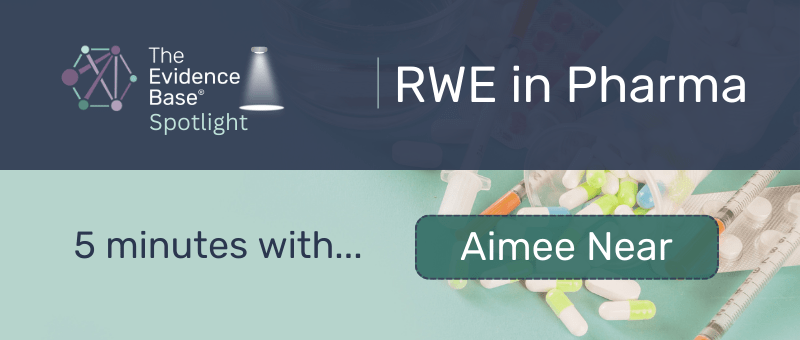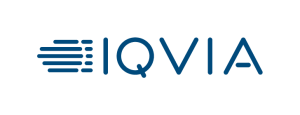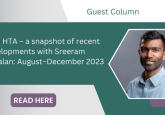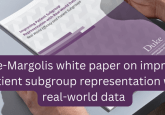RWE in Pharma: 5 minutes with…Aimee Near

In this ‘RWE in Pharma’ interview series, we are putting various pharma experts in the spotlight and asking them to share their insight on how their industry has traditionally employed real-world evidence (RWE), how they envision this changing over the next few years, and what their predictions of the impacts of the highly anticipated U.S. FDA RWE Framework may be.
This installment features Aimee Near, Principal of the Medical and Scientific Services team at IQVIA (NC, USA).
 Please could you introduce yourself, your organization(s) and tell us more about your role?
Please could you introduce yourself, your organization(s) and tell us more about your role?
My name is Aimee Near and I serve as a Principal within IQVIA’s USA Medical and Scientific Services team. As part of the company’s broader real-world evidence solutions group, we leverage secondary data to address our clients’ evidence needs in health economics and outcomes research.
 What are the main ways real-world data (RWD) and RWE have traditionally been – and are currently – used by pharma?
What are the main ways real-world data (RWD) and RWE have traditionally been – and are currently – used by pharma?
RWD, which is used to generate RWE, has been an important part of pharma’s evidence generation strategy for many years. Most are familiar with the use of RWD in traditional post-marketing safety studies, and in health economics and outcomes research (HEOR) to understand treatment patterns. This could include patient adherence and physician prescribing practices, economic and clinical burden of disease, risk factors for poor outcomes, and patient populations with high unmet need despite currently available therapies and comparative effectiveness research.
However, in recent years, the industry has begun using RWD to inform and modernize clinical trial design. RWD can be used to minimize the time required to identify trial sites and recruit eligible patients. It also can be used to form an external control arm that serves as a comparator, essentially a cohort of patients external to the trial who are very similar to the patients that participate in the trial.
We are seeing increased use of RWD in regulatory approval and decision making, with the FDA publishing guidance on how RWE should be used in clinical development programs. I think this is an application that is really going to gain momentum in the next few years.
 How should pharma select the best RWD assets?
How should pharma select the best RWD assets?
For a given research question, you have to perform a data landscape assessment to identify the most suitable data sources. Suitability will be based on multiple factors: how robust the data is for the outcomes and key study measures of interest, the patient population covered in the database, and the representativeness of the data, to name just a few. Usually, when you go through this exercise, the field of possible resources will be narrowed considerably.
Also, it’s often necessary to pull together data from different sources. For example, if you need tumor staging information from electronic health records (EHR), and comprehensive healthcare resource utilization and costs from insurance claims, you’d need to link data from two sources to complete the patient journey. Linking across databases in a privacy-compliant manner is something we do at IQVIA using our patented and proprietary encryption algorithm. This combination, or enrichment, of EHR data assets allows us to leverage RWD to address more complex research questions.
 Do you think trust in RWE is increasing? What steps need to be taken to build this?
Do you think trust in RWE is increasing? What steps need to be taken to build this?
Across the board, yes. Awareness of, and trust in, RWE is increasing. The scientific community in general now views RWD as a complement to clinical trial data that can produce answers even faster and more efficiently than the standard randomized controlled trial (RCT). Additional guidance from regulators will only strengthen this view.
While payers have long understood the value of evidence derived from RWD, appreciation among other stakeholders, such as physicians and patient groups, is growing. Physicians, of course, generate RWD daily as they enter patient data into EHRs, so they have come to recognize and understand the use of such data in published studies. Equally, patient advocacy groups are generally very focused on involving their members in surveys and registries to provide the research community with answers to disease questions. So, both groups are attuned to what RWD can do.
Looking ahead, we can expect there to be further technological developments that will ensure the completeness, quality, and generalizability of the data, as well as novel analytical methods to account for biases. Plus, we’re continuing to see progress in accessing unstructured data, for example, using natural language processing, to answer research questions that are beyond the reach of codified, structured data fields.
 How do you see pharma’s use of RWD/E changing over the next five years?
How do you see pharma’s use of RWD/E changing over the next five years?
Overall, I think we’ll see an increased use of RWD to support regulatory decision making. We have seen off-label use in RWD which has supported label expansions and leveraging of RWD for external control arms. RWD is also evolving to include more novel data, such as data generated from wearables, as well as genomic data, which I am personally very excited about for the future of targeted therapy regulatory decisions. I think pharma’s use of RWD will continue to grow and be apparent in supporting more and more regulatory approvals.
 How do you think the COVID-19 pandemic has affected this trajectory and view of the value and usability of RWD/E?
How do you think the COVID-19 pandemic has affected this trajectory and view of the value and usability of RWD/E?
I think the pandemic has magnified the value of RWD/E, accelerating its trajectory. It has highlighted the need for data to address research questions in real-time, which is the greatest benefit of RWD, as there is no need to conduct a long, prospective study. With RWD, for example, we achieved fairly quick insights into the characteristics of patients being hospitalized with COVID-19. We now have data for all of 2020, and part of 2021, that is being used to understand why some patients experience more severe disease than others or why some are “long haulers”, otherwise known as long COVID. What were their co-morbidities? What are their demographics or other clinical characteristics? Studies of RWD are underway to provide the answers.
Disclaimers:
Aimee Near has no disclaimers to declare.
The opinions expressed in this feature are those of the interviewee/author and do not necessarily reflect the views of The Evidence Base® or Future Science Group.
In association with:







